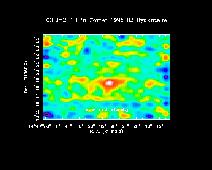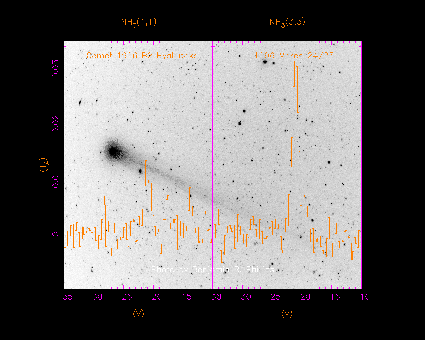


J. Mangum, NRAO
This image shows, in false color, the emission from carbon monoxide molecules in Comet C/1996 B2 Hyakutake shortly before it passed the Earth. The emission shows up as reddish/white here. The image was made on 21 March 1996, with the NRAO 12m radiotelescope atop Kitt Peak, Arizona, by Jeff Mangum using the newly implemented `on-the-fly' mapping technique. The spectral line here is very narrow, but emission has been integrated over all velocity channels to construct this image. The nominal telescope beam is 30" at 1.3mm wavelength, but the image was convolved to 40" resolution to improve the signal to noise ratio. As a comet warms on its journey around the sun, molecules boil off of the icy nucleus. CO boils off particularly far from the sun, when the nuclear temperature is only about 20 K, and powers activity in the comet's coma far from the sun. As the comet approaches the sun, the evaporation of other molecules powers increasingly violent activity. Three days after this image was taken, emission from ammonia molecules was detected with the NRAO 43m telescope in Green Bank, West Virginia. The ammonia emission suggested that the temperature of the gas near the nucleus was 67 K at that time, sufficiently warm for many molecules to leave the nucleus.

A. Wootten, B. Butler (NRAO), D. Bockelee-Morvan, J. Crovisier, (Observatoire de Paris-Meudon), P. Palmer (U. Chicago), D. Despois (Observatoire de Bordeaux), and D. Yeomans (JPL)
Ammonia is thought to contain a significant fraction of the nitrogen in cometary atmospheres (Crovisier 1993, Meier et al. 1994). Unfortunately, only a single unconfirmed detection has been reported, at centimeter wavelengths by Altenhoff et al. (1984) toward IRAS-Araki-Alcock. Estimates of the abundance of ammonia in P/Halley range over an order of magnitude. The close approach of C/1996 B2 (Hyakutake) during 1996 March suggested a new detection effort be made. Observations were made during the night of 1996 March 24/5 at the 43m telescope of the NRAO in Green Bank, West Virginia. We detected ammonia in both the (J,K)=(3,3) transition and in the inner three hyperfine components of the (1,1) transition of ammonia. In the former, we measured T_R(3,3) dv = 0.222 +- 0.013 K km/s and T_R(1,1) dv = 0.130 +- 0.015 over the inner three hyperfine components.
The kinetic temperature of the gas may be estimated from the rotational temperature of the ammonia molecules. At the inner coma densities, the ammonia metastable transitions should rapidly reach thermal equilibrium with the gas. The (J,K)=(3,3) line arises from ortho-ammonia, assumed to be three times as abundant as the para-ammonia giving rise to the (J,K)=(1,1) line. Adopting this abundance ratio, an LTE model of ammonia emission suggests that the observed ratio R = T_R(3,3) dv/ T_R(1,1) dv = 1.7 +- 0.2, Such a ratio is achieved at a rotational temperature of ammonia of Trot=67 +- 5K, which we take to reflect the kinetic temperature of the gas.
A preliminary estimate of the ammonia production rate may be achieved through a simple model which suggests a production rate Q[NH3] of about 1.0 x 10(27) per second. For a water production rate of 3.5 x 10(29) inferred by OH observations on the date of our observations from IUE (Festou et al., IAU Circular 6355), we find an ammonia abundance of about 0.25% that of water. For comparison, Meier et al. (1994) estimate a production rate of 1.5 {+0.5}_{-0.7}% relative to water in P/Halley, from an analysis of observations from the Giotto spacecraft. Estimates of the ammonia production rate from observations of its presumed daughter species, NH2 and NH, vary, partly owing to uncertainty in the NH2 photodissociation rates, but generally lie near or above the value we observe, for P/Halley (Meier et al 1994). Hence, the NH3 abundance in comet C/1996 B2 lies at the extreme lower range of values deduced from P/Halley observations of NH and NH2 radicals, and much below those measured for P/Halley from Giotto mass spectroscopy.
The spectra are displayed below against a backdrop of a photo of the comet
taken the same evening from Green Bank by Benjamin Phillips. For the original,
please see The University of
Virginia Comet Page .
This image shows, in the background in false color, a photograph of
Comet C/1996 B2 Hyakutake on 23 March 1996 from Green Bank by Benjamin
Phillips, a U. Va. student in Craig Sarazin's class. Superimposed on this
are the spectra of two transitions of ammonia, observed at the NRAO 43m
telescope in Green Bank on 24/25 March 1996 by Alwyn Wootten. On the left is
the (1,1) transition and on the right is the (3,3) transition. From comparing
the strengths of these two lines, the temperature of the gas is measured
to be 67K. Ammonia had not previously been directly detected in cometary
atmospheres, primarily because it is easily destroyed by solar radiation.
Because Hyakutake passed so close to Earth, the region of ammonia emission
was larger than in more distant comets--in fact it was just about the size
of the 43m telescope's primary beam.
The products of that destruction, NH$_2$ and NH, had been observed previously
in other comets. From these observations, astronomers knew that ammonia
was scarce in comets, compared to water. The observation shown here
suggests that there are only two or three ammonia molecules for every thousand
water molecules emanating from the surfact.
An attempt to image the ammonia emission from Hyakutake using the Very
Large Array did not provide a detection.
The close approach to the Earth of comet C/1996 B2 (Hyakutake) in March
1996 allowed searches for minor volatile species outgassed from
the nucleus. We report the detection of deuterated water (HDO) through its
101--000 rotational transition at 464.925 GHz using the
Caltech
Submillimeter Observatory. We also present negative results of a sensitive
search for the J(5--4) line of deuterated hydrogen cyanide (DCN) at 362.046
GHz.
Simultaneous observations of two rotational lines of methanol together with HDO
in the same spectrum allow us to determine the average gas temperature within
the telescope beam to be 69 +/- 10 K. We are thus able to constrain the
excitation conditions in the inner coma and determine reliably the HDO
production rate as (1.20 +/- 0.28) X 1026 s-1 on March
23-24, 1996. Available IR, UV and radio measurements lead to a water production
rate of (2.1 +/- 0.5) X 1029 s-1 at the time of our HDO
observations. The resulting D/H ratio in cometary water is thus (29 +/- 10)
X 10-5, in good agreement with the values of
(30.8+3.8-5.3)
X 10-5 (Balsiger et al. 1995) and (31.6 +/- 3.4) X 10-5
(Eberhardt et al. 1995) determined in comet P/Halley from in
situ ion mass spectra. The inferred 3sigma upper limit for the D/H ratio in
HCN is 1%.
Deuterium abundance is a key parameter for studying the origin and the early
evolution of the Solar System and of its individual bodies. Our HDO measurement
confirms that, in cometary water, deuterium is enriched by a factor of at least
10 relative to the protosolar ratio, namely the D/H ratio in H_2 in the
primitive Solar Nebula which formed from the collapse of the protosolar cloud.
This indicates that cometary water has preserved a major part of the high D/H
ratio acquired in this protosolar cloud through ion-molecule isotopic
exchanges or grain-surface reactions and was not re-equilibrated with H_2 in
the Solar Nebula. However, there are strong presumptions that
interstellar grains were partly mixed in the early nebula prior to cometary
formation with water reprocessed in the warm inner part of the nebula and
transported by turbulent diffusion. Scenarios of formation of comets
consistent with these results are discussed.
The paper describing this work will appear in Icarus; a preprint may be obtained
from the
NRAO preprint site.


Deuterated Water in Comet C/1996 B2 (Hyakutake)
and its Implications for the Origin of Comets
D. Bockelee-Morvan, D. Gautier, D.C. Lis, K. Young, J. Keene, T. Phillips,
T. Owen, J. Crovisier, P.F. Goldsmith, E.A. Bergin, D. Despois, A. Wootten
Abstract

Go to a
Home Pagesummary of comet papers I have coauthored.
Back to my
Home Page